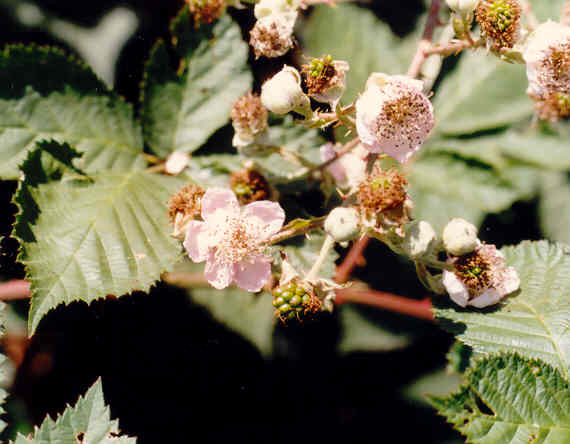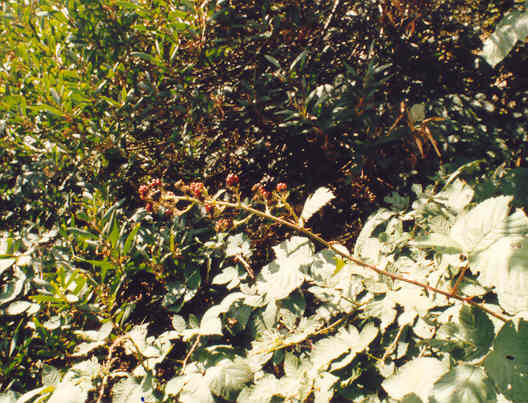
Rubus procerus P.J. Muell.
= Rubus discolor Weihe & Nees
|
|
Rubus procerus P.J. Muell.= Rubus discolor Weihe & Nees
Rosaceae (Rose Family)EuropeHimalayan BlackberryHimalaya Berry |
June Photo
Plant Characteristics:
Sprawling somewhat evergreen, rough very prickly briar with entangled
canes to 10 ft. high or long and prostrate parts rooting at tip; lvs. of
primocanes large, 5-foliate, becoming glabrous on upper face, canescent or
tomentose on lower face; lfts. broad-ovate to nearly rounded, 4-5 in. long and
often nearly as broad, often subcordate at base, very abruptly pointed, margins
rather coarsely and unequally serrate-dentate; fls. in conspicuous projecting
terminal panicles; fr. black, thick, large and succulent.
Habitat:
Cultivated as a berry and also spontaneous.
(Bailey 524). Bloom date not
given in Bailey but I observed my
specimen blooming in May and June. (my
comment).
Name:
Ru-bus, the classical name, associated with ruber, red.
(Bailey 520). Procerus,
tall. (Bailey 20).
General:
Rare in the study area having been found only on the bank below the
Newporter Apartments in Big Canyon. (my
comment). Rubus, brambles, including
blackberries, dewberries, raspberries and certain species grown for ornament and
ground-cover. The first-year growth
or primocane commonly not bearing fls., in the second year growth or floricane
producing a different set of lvs. with fls. and frs., the floricane often dying
at the end of the season, although in a few introductions, big woody species
remain alive and productive for two or more years.
Pistils are few to many, simple, aggregated in center on an elongated
receptacle or cone, each pistil becoming a sarcose drupelet and cohesively
forming an edible "berry", a blackberry or dewberry when the core
removes with the adhering drupelets, a hollow cone or raspberry when the core
remains on the plant. A very large
and variable genus around the world, more than 400 species are known in N. Amer.
The kinds have been much confused because of insufficient and inadequate
herbarium specimens, whereby the species cannot be determined; as a result, the
taxonomic custom has developed of calling the strange forms hybrids, yet the
hybridity can be nothing more than a blind guess until the species of the
parents are known. In some parts of
the country great quantities of wild blackberries are picked and marketed, even
though the species of them may not yet have been made out. (Bailey 519).
There are several species of Rubus native to California.
The most common native is R. vitifolius (California blackberry).
The cultivated common blackberry (R. laciniatus),
and Himalaya berry, (R. procerus) are frequently escapes, becoming
troublesome weeds along fences and ditches, and occasionally in orchards and
fields. (Robbins et al. 249).
Favored by rats for food, shelter. (Hickman
, Ed. 974). The
leaves, roots and fruit of R. villosus, a species of the middle U.S., are
rich in tannin and therefore a good astringent and tonic, long a favorite home
remedy for diarrhea. Also used by
some for offensive saliva. (Meyer
24). The
raspberry, R. idaeus has long been established as a remedy for dysentry and diarrhea, especially in infants.
It is much used in relief of urethral irritation and is soothing to the
kidneys, urinary tract and ducts. Tincture
of raspberry, 10-40 drops. (Hutchens 158).
Blackberries, R. villosus were used as food and medicine by Native
Americans; today we know by their experience, and by scientific proof, that the
plant is exceedingly valuable in chronic diarrhea, dysentry, cholera, and summer
complaints of children and is often the only thing that gets results.
A decoction of the root or leaves or both may be used freely, four to
five times a day. (Hutchens 32).
Text Ref:
Bailey 524; Hickman, Ed. 974.
Photo Ref:
June 90 # 9A,10A; Jun-Aug 90 # 5.
Identity: by R. De Ruff, confirmed by John Johnson.
First Found: June 1990.
Computer Ref: Plant Data 397.
Plant specimen donated to UC Riverside in 2004.
Last edit 8/8/05.
 |
June Photo